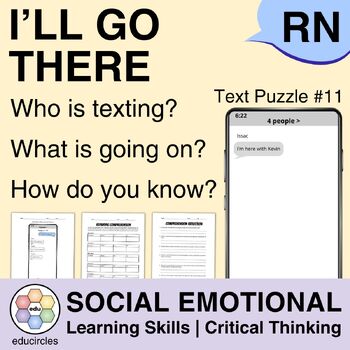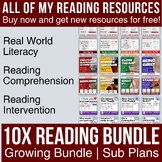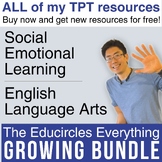I'll go there RN | Critical Thinking Text Puzzle 11 Sub Plans | Social Emotional
- PDF
Also included in
- Reading Comprehension and Reading Intervention GROWING Bundle for Middle School and struggling High School students.This is a growing collection of ALL of my reading comprehension resources. What's the difference between the 10x Reading Bundle and the Reading Mega Bundle?This resource (10x Reading GPrice $49.99Original Price $240.47Save $190.48
- Can your Middle School students figure out who is texting? 14+ Critical Thinking Text Message Puzzles: Real world social-emotional learning that isn't babyish. Use these high-interest text message conversations as part of your regular English Language Arts program. Great as emergency sub plans for MPrice $19.99Original Price $62.47Save $42.48
- This growing bundle includes every single resource in my TPT store. Buy now and get all future resources for free!Oh no, you missed out! This resource was on sale for $100 to celebrate 100,000 downloads across my TPT store. Make sure to join the Educircles Club Newsletter to get free stuff and speciPrice $146.00Original Price $515.47Save $369.47
Description
Here's a Critical Thinking Text Message Puzzle for Middle School students! How quickly can your class figure out who is texting?
Here's part of the text message conversation:
- I'm here with Kevin
- Oh you guys are here
- Low key I was walking around I'll go there rn
- ... (look at the product preview PDF to see the last line)
Who is speaking? What is going on? How do you know that?
This is the full Reading Comprehension lesson
- The slideshow lesson goes through each text message clue one-by-one.
- Systematic and Cumulative Learning: Students fill out two reading comprehension graphic organizers as they read ("It Says, I Say, And So" and "Somebody Wanted But So" worksheets.)
- Real-World Literacy and Social-Emotional Learning: Students reflect on how they applied critical thinking strategies and how it relates to school and the real world (i.e. self-awareness, social-awareness.)
CLICK HERE to get the NO PREP JUST PRINT AND GO version
- Download and print the PDF.
- It has the text puzzle, Bloom's Taxonomy discussion questions and answers.
✨FEEL CONFIDENT explaining reading comprehension answers to students by using the 16 page answer key and discussion guide/script.✨
In this fun Critical Thinking Puzzle #11, students are shown one text message at a time.
- Each slide in this critical thinking puzzle reveals another text message.
- Eventually, students have enough clues to solve the critical thinking puzzle!
- There's also a foldable printable version so if you're doing small groups or independent literacy centers, students can unfold one clue at a time!
INSTRUCTIONS:
STEP 1: Open the slideshow lesson. (When you download this PDF resource, there will be a link to the Google Slideshow.)
STEP 2: Print the PDF file. It has the worksheets.It also has a detailed 16 page answer / discussion guide to help you guide student conversations.
TEACHING IDEAS:
- Option 1. Whole class instruction: Students copy down clues from the slideshow onto the first worksheet. The act of copying down information might help them pay attention to subtle clues.
- Option 2. Some students may have trouble seeing the board or copying down the clues. There is a version of the worksheet with the text messages. There is also a large version of the phone mock-up.
- Option 3. Independent Literacy Center: Use the foldable version of the handout. Fold each clue on the dotted line. Students at the literacy center unfold the handout one clue at a time. They record answers on their own worksheet.
Why use this Critical Thinking Puzzle / Activity?
- This Critical Thinking puzzle uses text messages to hook your Middle School students.
- But, you actually need to use a lot of reading comprehension strategies to solve this critical thinking puzzle.
- Students have to predict, infer, and make connections to figure out who is talking and what is happening.
- They document their learning by filling out a graphic organizer and answering the comprehension reflection questions.
- Yay, assessment and evaluation opportunities. Sometimes students try harder if things are "for marks." Plus, you need evidence of learning for report cards, so it's win:win!
Perfect for a fun English Language Arts class to explore Critical Thinking or Reading Comprehension Strategies.
- Use this critical thinking puzzle as part of a digital literacy lesson on text messaging.
- A fun critical thinking activity to explore reading comprehension strategies (It Says, I Say, And So and Somebody Wanted But So)
- This is not your average critical thinking puzzle - it's a way to build transferable life skills
Feb 25, 2023 update: OH NO, YOU JUST MISSED OUT!
THIS CRITICAL THINKING PUZZLE WAS FREE FOR A LIMITED TIME!
- I like to publish my resources for free (or heavily discounted) at the beginning as a thank you to my followers.
- 37 teachers got this resource for free!
- They got the paid upgrade for free as well. (I just updated this resource to include the answer key.)
DON'T MISS OUT!
- FOLLOW my TPT store to find out about the next freebie!
- SUBSCRIBE to the Educircles Club newsletter for specials (that TPT won't let me talk about on their platform.)
Questions about this Critical Thinking Text Puzzle #11? Ask in the TPT Q&A section or email Mike@educircles.org








